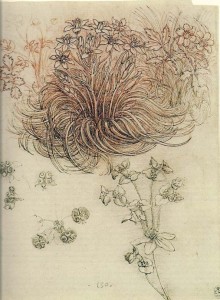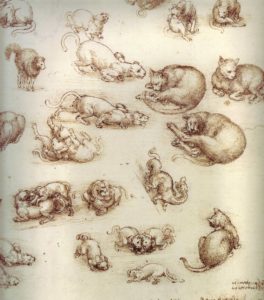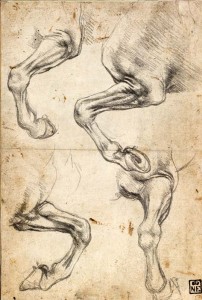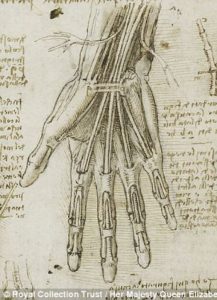By Marcia Rackow
Special Article reprinted from The Journal of the Print World, Summer 2003.
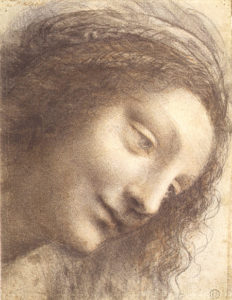
Art has been loved, treasured, and the museums these days are overflowing with people hoping to see beauty in this world—and be moved by it, as was seen in the recent show at the Met, “Leonardo da Vinci: Master Draftsman.” But people haven’t known what Aesthetic Realism, the philosophy founded in 1941 by the American poet and critic Eli Siegel, explains—the urgency art has for our lives!
The most important question facing every person and nation today is—How should we see the world we are in and the people close to us and far away? Aesthetic Realism shows the honest, practical answer is in aesthetics.
“The perfect work of art,” Mr. Siegel wrote in Self and World:
“is that where the artist, while entirely himself, while a unique individual, also sees an object in its completeness and precision. If it is possible; if, in fact, it is the great purpose of art to be one’s self and yet give everything to the object—can we not find here the just purpose of life itself?”
This is revolutionary! I’ve learned that the art way of seeing is the same as ethics and kindness because it is fair to the structure of the world and every person. “All beauty,” Eli Siegel stated, “is a making one of opposites, and the making one of opposites is what we are going after in ourselves.” Studying this landmark principle opened my eyes to a new, kind, useful way of seeing art, people, the world itself.
I learned, too, that there is something completely opposed to the art way of seeing in us—the feeling we’ll take care of ourselves, be important, through looking down on everything and everybody. This is contempt, which Mr. Siegel described as “the addition to self through the lessening of something else.” Contempt is as ordinary as a wife making a sarcastic remark to her husband, and as terrifying as a government’s drive to have its way no matter what the facts warrant or how many people get hurt.
“The only true combatant of contempt,” Mr. Siegel wrote, “is aesthetics.” And opposites that are emergent for people today to make sense of are rigidity and flexibility, assertion and yielding. A person can be rigid, stubborn, and can also be strategically flexible in order to gain advantage. Women do this with men, and nations do it with each other. We have to feel that trying to be fair, trying to understand the feelings of people, is strength, freedom, grand self-expression. This is what the art of Leonardo da Vinci shows magnificently.
1. The Flexibility that Is Also Strength
The great Florentine man of the Renaissance, Leonardo da Vinci, lived from 1452 to1519. As I studied his drawings in the recent exhibition at The Metropolitan Museum of Art and saw the scope of his work in the arts and sciences—his investigations of light and shadow, perspective, architecture, anatomy, astronomy, botany, physics, mechanics, and his writings about them, my respect and admiration grew. In his art, he answers a question that is raging in the world today. What is a true relation of flexibility and firmness? Is yielding to the facts of this world weakness or strength? This is a question every person needs to answer honestly, and is crucial for every government leader.
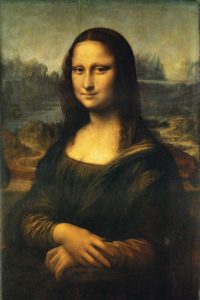
Mr. Siegel wrote in his essay “Art as Flexibility”:
Art shows reality as resisting, bending; asserting, fading—which is how it is….Yieldingness as sight is much in pictures; the yieldingness that makes for strength is what we look for in art.
And this is what people found in Leonardo. From his earliest works we see him dealing centrally with these opposites—culminating in the great work that has come to stand for the art of painting itself—the Mona Lisa. “In Leonardo da Vinci,” Mr. Siegel wrote, “import is got through the visual as yielding, flexible.”
The power of his work is in his yielding to the delicate and mighty shows of the universe. “Possessed of an unquenchable thirst for knowledge,” writes the critic Robert Goldwater,
he investigated nature in all her aspects. For him art and science were two closely related activities, two means for describing the physical world. “The mind of the painter,” wrote Leonardo, “should be like a mirror which is filled with as many images as there are things placed before him.”
We can see this in his exquisite studies—of plants, animals, anatomy, astronomy, meteorology, ballistics.
And da Vinci writes about understanding the feelings of people:
A good painter has two chief objects to paint: man, and the intentions of his soul; the former is easy, the latter hard, because he has to represent it by the attitudes and movements of the limbs.
He was interested in the range of human emotion and expression, including the grotesque. “[Leonardo],” writes Walter Pater,
learned…the art of going deep, of tracking the sources of expression to their subtlest retreats, the power of an intimate presence.
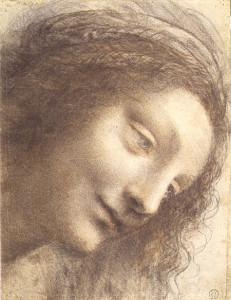
We see this in his beautiful drawing Head of the Virgin in Three-Quarter View Facing to the Right. While her face has a firm classical, sculptural quality composed of large, simple planes, there is at the same time such softness, delicacy. There is a beautiful curved movement as the turban encircles her face, with her hair falling in curls on the right that give such a feeling of flexibility and yieldingness, but this is not limp or excessive because Leonardo counters the downward motion of her head with the strong diagonal line of her neck from the lower left to the upper right.
Through Leonardo’s “sfumato” technique—that smoky quality—he softens the edges of things. “Da Vinci,” Mr. Siegel wrote, “was after…softening lines, making them misty, atmospheric, mysterious….The definite, the unyielding were given yieldingness, mobile gentleness.” The entire composition is a breathtaking oneness of flexibility and firmness.
2. What Can We Learn from This?
“People feel they are not flexible enough,” explains Chairman of Education Ellen Reiss in The Right of Aesthetic Realism to Be Known:
“They don’t meet new things, surprises, with grace. And people despise themselves for being flexible in a bad way: ready to tailor themselves for the company they’re with and for whatever can make them important. Wrong flexibility is the being unprincipled; it is also moodiness. And firmness has too often been the insistence on having one’s way.”
These sentences describe me. I was once in a terrific fight about these opposites. In my diary I used to curse myself for being too yielding. I wrote: “Good old subservient, docile me. If I can only remember to ask questions, challenge, argue, maintain my integrity.” And I accused myself of: “1. Being submissive, 2. Asserting no independence.”
I gave myself orders: “Be an individual who counts. Don’t be that sweet jellyfish. Have a little backbone.”
What I despised myself for was the way I went after people’s approval, and was ready to be flexible, ingratiating, and amenable in order to get it. I was more interested in showing how indispensable and caring I was, than in wanting to know a person, strengthen him or her. And the other side of my submissiveness was a stubbornness like a rock. I was strategic—sweet when I thought it served me, and stubborn because I thought my way was the only way.
In an Aesthetic Realism class, Mr. Siegel spoke to me about these opposites, and asked me, in painting terms: “Do you think curves and angles are working well in you?” When I said, “No, I don’t think so,” he described the fight in me:
Marcia Rackow would like to be very sweet and yielding and show how kind she is [that would be curves], and also be strong and show no one can take advantage of her, and that would be angles.
And he gave form to this fight I had been in all my life, by showing me it was a question of art—and had an aesthetic solution! I needed to have one purpose in being strong and being yielding—and that purpose was to have good will: “the desire to have something else stronger and more beautiful, for this desire makes oneself stronger and more beautiful.” I am tremendously grateful that through my study of Aesthetic Realism, I have been able have this purpose increasingly in my life.
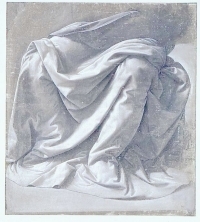
To bring out the strength and beauty of a thing is the purpose of art, and that is what we see in Study of Drapery for the Legs of a Seated Figure, c. 1473. Here, curves and angles, flexibility and strength are together in a way that is magnificent. The effect is so sculptural it is hard to believe it’s a drawing. The cloth has such weight and volume we think we could touch it. Leonardo has captured the flexibility of the fabric, and we feel a great tenderness in it as it drapes around the legs, revealing the forms underneath—the curve of the calf, the arch of the foot. We feel those legs—we feel a living person is present. Do we need—in fact, is it urgent for us—to give people and objects the depth, the solidity, the weight the artist gives to this person and these objects? Could we hurt a person we saw as having this reality, this substance, this depth?
That large curve of fabric that drapes down from the knee across to the foot looks so easy, so flexible. Though the light is strong, accenting the firmness of the legs and fabric, there is a tremendous subtlety in the gradations of light and dark. We see Leonardo’s love of the softening effect of shadow as folds disappear into dark, mysterious recesses. In this beautiful work is a guide to how we need to see other human beings.
When I was 18, I wrote:
What is art? Do I really care about the people I will draw? Yes, but I will be able to do nothing for them through art. I cannot be a humanitarian. I cannot change the world. I cannot eliminate suffering.
I say now—and it is the pride of my life—that art, fully understood and loved, can change the world, can make human beings truly kinder; in fact, aesthetics is the one means to that. And that is why Aesthetic Realism needs to be studied by people everywhere on this earth.
Marcia Rackow is an artist, and consultant on the faculty of the Aesthetic Realism Foundation, a not-for-profit educational foundation in New York City, where she teaches the museum/gallery course The Visual Arts & the Opposites and The Art of Drawing: Surface & Depth.
